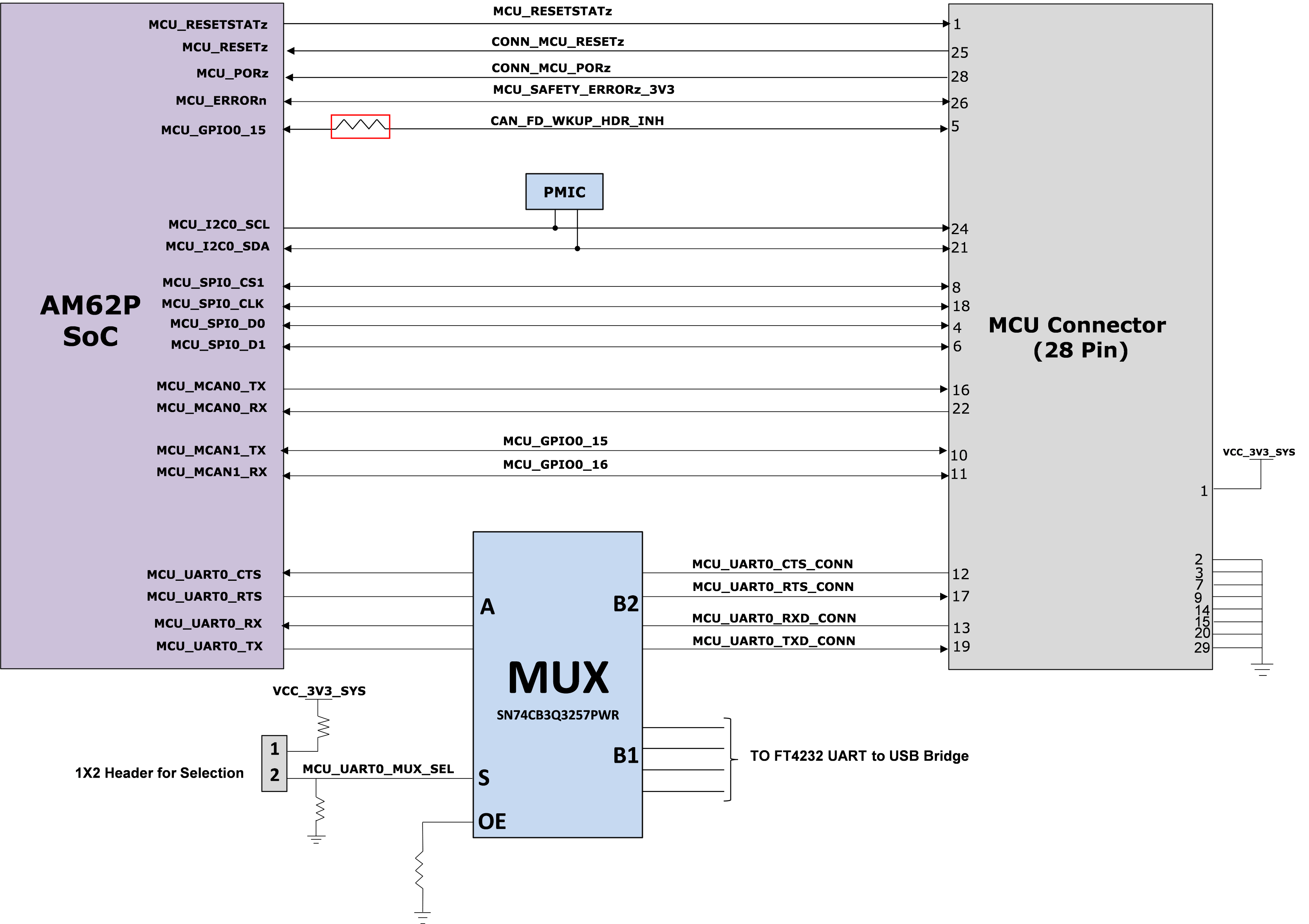SPRUJA2 November 2023
- 1
- Description
- Get Started
- Features
- 5
- 1Evaluation Module Overview
-
2Hardware
- 2.1 Additional Images
- 2.2 Key Features
- 2.3 Interface Mapping
- 2.4 Power ON/OFF Procedure
- 2.5 Clocking
- 2.6 Reset
- 2.7 CSI Interface
- 2.8 OLDI Interface
- 2.9 DSI Interface
- 2.10 Audio Codec Interface
- 2.11 HDMI Display Interface
- 2.12 JTAG Interface
- 2.13 Test Automation Header
- 2.14 UART Interface
- 2.15 USB Interface
- 2.16 Memory Interfaces
- 2.17 Ethernet Interface
- 2.18 GPIO Port Expander
- 2.19 GPIO Mapping
- 2.20 Power
- 2.21 EVM User Setup/Configuration
- 2.22 Expansion Headers
- 2.23 Interrupt
- 2.24 I2C Address Mapping
- 3Hardware Design Files
- 4Compliance Information
- 5Additional Information
2.22.2 MCU Connector
AM62P SK EVM has a 14 x 2 standard 0.1” spaced MCU connector which includes signals connected to the MCU Domain of the SOC. The connected signals include MCU_I2C0, MCU_UART0 (with flow control), MCU_SPI0 and MCU_MCAN0 signals. Additional control signals connected on the header includes CONN_MCU_RESETz, CONN_MCU_PORz, MCU_RESETSTATz, MCU_SAFETY_ERRORn, 3.3V IO supply and GND. MCU_UART0 signals from AM62P SOC are connected to both MCU Header and FT4232 Bridge through a MUX Mfr Part # SN74CB3Q3257PWR. The MCU Header does not include the Board ID memory interface. The allowed current limit is 100 mA on 3.3V rail.
 Figure 2-28 MCU Connector
Interface
Figure 2-28 MCU Connector
Interface| Pin No. | SoCBall No. | Net Name |
|---|---|---|
| 1 | - | VCC_3V3_SYS |
| 2 | - | DGND |
| 3 | - | DGND |
| 4 | D10 | MCU_SPI0_D1 |
| 5 | F8 | CAN_FD_WKUP_HDR_INH |
| 6 | B11 | MCU_SPI0_D0 |
| 7 | - | DGND |
| 8 | E10 | MCU_SPI0_CS1 |
| 9 | - | DGND |
| 10 | F8 | MCU_GPIO0_15 |
| 11 | E7 | MCU_GPIO0_16 |
| 12 | B8 | MCU_UART0_CTS_CONN |
| 13 | B6 | MCU_UART0_RXD_CONN |
| 14 | - | DGND |
| 15 | - | DGND |
| 16 | E8 | MCU_MCAN0_TX |
| 17 | B7 | MCU_UART0_RTS_CONN |
| 18 | C10 | MCU_SPI0_CLK |
| 19 | C8 | MCU_UART0_TXD_CONN |
| 20 | - | DGND |
| 21 | D11 | MCU_I2C0_SDA |
| 22 | D6 | MCU_MCAN0_RX |
| 23 | F14 | MCU_RESETSTATz |
| 24 | E11 | MCU_I2C0_SCL |
| 25 | F11 | CONN_MCU_RESETz |
| 26 | G6 | MCU_SAFETY_ERRORz_3V3 |
| 27 | - | DGND |
| 28 | H6 | CONN_MCU_PORz |